Combating head injuries in youth sports
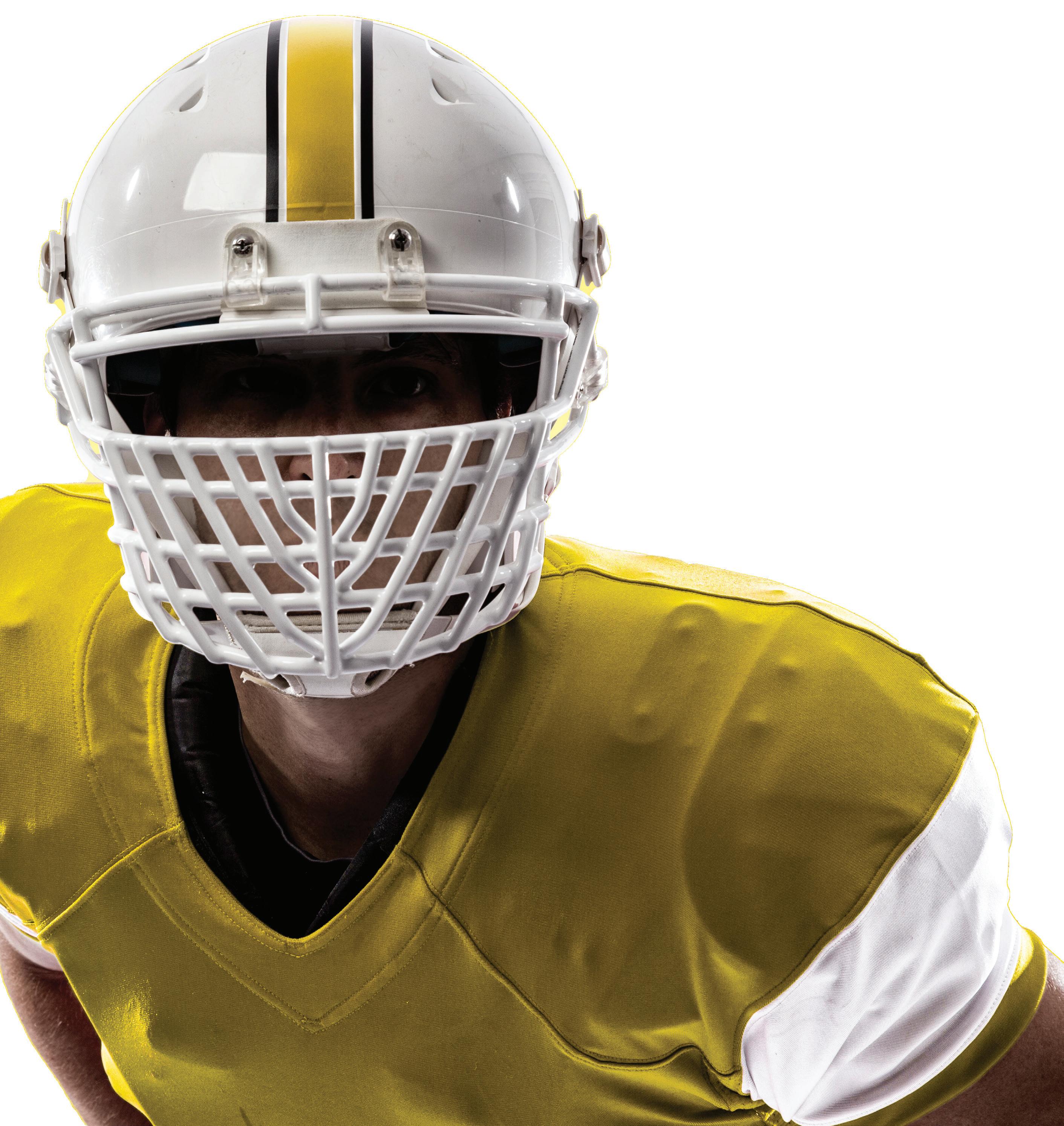

Fit & Fierce
A week-by-week guide to better health





Combating head injuries in youth sports


A week-by-week guide to better health




And award winning care to give you more faith in your footing.










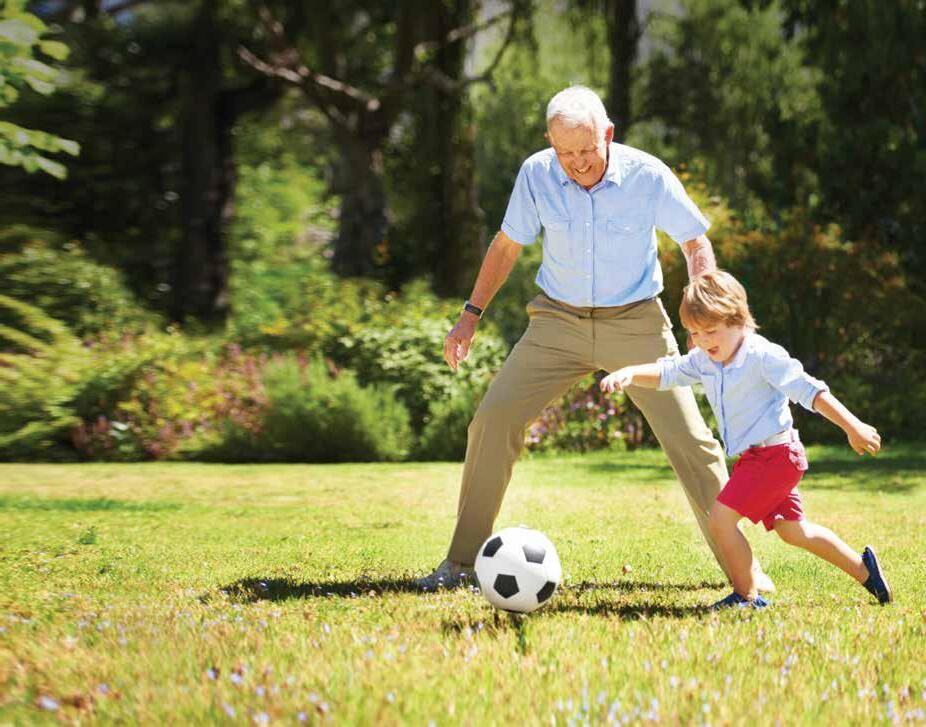
While Florida Hospital may be new to you, we’ve been a leading health system for more than a century. We are proud to bring our medical expertise, experience and leadership to Ocala, as we deliver our unique brand of inspired and compassionate health care.



And with Florida Hospital’s commitment to whole-person health, you’ll benefit from a higher-quality experience.
This is just the beginning, we have more exciting changes ahead. We look forward to a healthy future together.
PRESENTED BY:
COLLEGE OF CENTRAL FLORIDA
OCTOBER 24, 2018
Hors d’oeuvres, dessert and wine tastings, plus more than 80 vendors offering the latest in wedding styles and trends
Accommodations
The Waterfront Inn
Beauty
All Day Glam by Kimber
Dermalase Medical Spa
Envious Eyebrows
Ideal Image
Mary Kay
Meraki Studio

Nereyda Fernandez- Stylist
Pushti Brows & Skin Therapy
Simply Stunning
Cakes & Sweets
Color Sugar
Sara Fay Farm Gluten Free Bakery
Catering
David’s BBQ & Catering
Honey Baked Ham
Mojo’s Grill & Catering
Todd & Shelly’s Farm Fresh
Cafe & Pub
Entertainment
Rocket Entertainment
Event Design & Decor
Bella Faire Events & Weddings
Party Time Rentals
Simply Elegant Events
Unforgettable Events
Fine Jewelry
Lady Jeweler
Fitness
Orange Theory Fitness
Floral Design
Blooming Events
Cynthia’s Divine Designs
Pine & Petal
Gift Registries
Bridal Registry, Inc.

Dillard’s
Gowns & Formal Wear
The Event Warehouse
The Paddock Mall
Tuxedo Express
Home/Decor
Budget Blinds
Granite Wishes
Sleep Number

Horse & Carriage
Destiny Horse & Carriage
Insurance
Gibbs Insurance & Financial
Lauren Gibson State Farm
Medical
Recharge Clinic
Novelties
Athena’s Novelties
Nutrition
Le-Vel Independent Brand
Promoter
Vitalize Natural Market
Photo Booth PixelPro Events
Photography
BCG Pictures
Jim Jernigan’s Studio
Real Estate
Great Expectations Realty
Canterbury Circle
Venues
Appleton Museum
College of Central Florida
Golden Hills Country Club
Golden Ocala Golf & Equestrian Club
Herlong Mansion Bed & Breakfast
Hilton of Ocala
Indigo Harvest Events
Sweetwater Branch Inn
The Villages Polo Club
The Waterfront Inn
Wedding Venue 4 U
Winery
Island Grove Winery
..... and more to come
Door prize giveaways, including weekend getaways, high-end small appliances, beautiful purses and more.
FIRST 50 BRIDES WILL RECEIVE A GIFT BAG FILLED WITH EXCLUSIVE GOODIES
Get your tickets today by visiting ocalastyle.com Tickets are $10 in advance or $15 at the door (cash only)
Sponsors:
› PAGE 24
A look at the rise in popularity of minimally invasive cosmetic procedures.

› By Nick
SteeleCreating
McFarland›
Gibson› PAGE 32
HEALTHY beat
› PAGE 5
TRENDS | NEWS | PEOPLE
By Cynthia Brown, Karin Fabry-Cushenbery, Laurel Gillum, JoAnn Guidry, Bonnie Kretchik and Cynthia McFarland
› 6 What to do this month.
› 8 Healthy Living’s Hometown Heroes.


› 10 Learn something new.
› 11 Hope in health care.
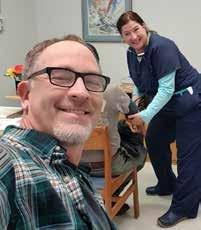
› 12 All around town.
› 14 Calling all brides!
HEALTHY body

› PAGE 15
WELLNESS | FITNESS | BEAUTY
By Robin Fannon, Laurel Gillum, John Jernigan
and Lisset Lanza› 16 End of summer salad.

› 18 Eat healthy, be healthy.
› 19 The Dirty Dozen.
› 20 Newbie runners, listen up!
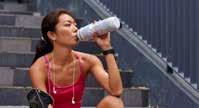
HEALTHY vibe
› PAGE 43
MIND | HOME | LIFE
By Laurel Gillum & Lisset Lanza› 44 The power of plants.
› 46 Happy marriage, happy life.
› 47 Got home equity?
› 48 Breaking bad (habits).
PUBLISHER Kathy Johnson kathy@healthylivingmagazines.com
OFFICE/PRODUCTION MANAGER
Cynthia Brown art@healthylivingmagazines.com
EDITORIAL
EXECUTIVE EDITOR
Karin Fabry-Cushenbery karin@healthylivingmagazines.com
MANAGING EDITOR
Melissa Peterson melissa@healthylivingmagazines.com
SOCIAL EDITOR
Ron Wetherington
SOCIAL MEDIA SPECIALIST
Vianca Torres vianca@ocalastyle.com
SOCIAL MEDIA ASSISTANT
Elizabeth Martinez
FOOD & LIFESTYLE CONTRIBUTOR
Robin Fannon
CONTRIBUTING WRITERS
Jim Gibson
Laurel Gillum
JoAnn Guidry
Bonnie Kretchik
Cynthia McFarland
Katie Benscoter
Nick Steele
Sean Trapani
EDITORIAL INTERN
Lisset Lanza
ART art@healthylivingmagazines.com
CREATIVE DIRECTOR
Jessi Miller
GRAPHIC DESIGNER
Kristy Taylor
PHOTOGRAPHERS
John Jernigan
Sheila Hartley
Ralph Demilio 123rf.com
SALES DIRECTOR OF SALES
Dean Johnson deanjohnson@healthylivingmagazines.com
SALES MANAGER
Sharon Morgan
ACCOUNT EXECUTIVES
Evelyn Anderson
Kyle K. Bernhard
Skip Linderman
Peggy Sue Munday
Cecilia Sarco
Lori Tani
Crystal Gale Tronnes
DISTRIBUTION
Dave Adams
Debra McQueen
Rick Shaw
O CALA PUBLICATIONS, INC. o: 352.732.0073
HEALTHY LIVING MAGAZINE has brought together a group of medical experts and community leaders to serve on our advisory board and share their expertise and insight with our readers.
Christy Jergens, APR Public Information O cer



FLORIDA DEPARTMENT OF HEALTH IN MARION COUNTY
Nicolas Blaser Vice President – Business Services O cer
BB&T
Michael Holloway, M.D. Physician-Directed Weight Management & Medical Aesthetics LIFESTYLE SOLUTIONS MEDSPA

Mark Jank, M.D. Ophthalmology OCALA EYE



Ashley Cauthen, M.D. Cosmetic And Clinical Dermatology MIDSTATE SKIN INSTITUTE

Brittney Marthaller Director, Marketing & Public Relations OCALA HEALTH
Kristina Donohue Director of Mission Advancement THE CENTERS
Derek Farr, D.O. Orthopedic Surgeon TWIN PALMS ORTHOPEDICS
Navinderdeep Nijher, M.D. Plastic Surgery OCALA PLASTIC SURGERY



Chris Okonkwo, M.D. Pediatrics

CHILDREN’S HEALTH OF OCALA
Cindy Grow, DNP, ARNP, AGPCNP-BC
Adult & Geriatric Integrative Medicine
PATIENT CENTERED HEALTH CARE & WELLNESS
Jayanti Panchal, M.D. Internal Medicine and Medical Weight Management SUCCESS BY DESIGN
Eastern equine encephalitis is a rare disease that is having a strong showing in Marion County this summer. As of press time, 11 horses and two emus have passed from the disease. Residents face an increased risk of disease being spread from mosquitoes through mosquito bites due to the number of local EEE cases. Deaths in horses and emus are a sign of increased spread of the virus in a community. Because of this, the Florida Department of Health in Marion County has issued a mosquito-borne illness advisory for Marion County residents. People should take precautions to prevent being bitten by mosquitos, including wearing long sleeves and pants when mosquitos are most active and using a repellent spray. Freestanding water from bird baths, buckets or stagnant water features should be eliminated.
Many people who are infected show no symptoms. Others may su er from flu-like symptoms, including fever, headache and sore throat. For those whose infection includes the central nervous system, a sudden fever and sudden headache may be quickly followed by seizures and a coma. Bottom line, protect yourself and your children.

Visit Ocala Downtown Market (every Saturday 9am-2pm)
Florida Safari at Silver Springs State Park (first Sunday of every month, 10am)
Organize a neighborhood cleanup.
Host a book exchange.

Meal prep for the week.
FaceTime a family member who lives out of town.
Read to the elderly at a local retirement home. Enjoy your day by starting a new book.
Take Control of Your Diabetes Support Group at the Senior Wellness Community Center
Make plans to attend Marion County School Days at Fort King on Sept. 8 and 22.
Pilates
Hip-Hop Yoga Flow at Studio SC: Barre, Yoga, Fitness (Every Monday, 6:45pm)
Register in advance for the Wear Your Wings Domestic Violence Walk on Sept. 15.
Low Back Pain and Sciatica Workshop at the Senior Wellness Community Center
Ocala’s First Friday Art Walk, 6-9pm
2nd Annual Ocala Recovery Fest at Tuscawilla Park
Hike at the Marshall Swamp Trailhead.
Buy ingredients for a new dinner recipe.

End of Summer Bash! at Tuscawilla Park
Pilates
Pressure
Chair Yoga at Blissful Life Corporation (Every Wednesday, 10:30am)
Make plans to attend Oktoberfest 2018 at Tuscawilla Park on Sept. 22.
Pilates
Rollerblade at the Baseline Trailhead of the Cross Florida Greenway.
Tune into the NY Yankees @Tampa Bay Rays game at 7:10pm.

Schedule dental visits for the kids.
Make plans to attend the Be the Change bullying prevention event on Sept. 29 at Citizens’ Circle.
Pilates
After Dark in the Park Movie Series: Remember the Titans at the Martin Luther King Recreation Complex
Cornerstone Leads the Way 5K at the Baseline Trailhead of the Cross Florida Greenway
Impact of Uncontrolled Diabetes Seminar at the Senior Wellness Community Center
Walk to End Alzheimer’s Ocala at Tuscawilla Park
As the hot weather comes to a close (soon, we promise), so do the long, lazy days of summer. Take part in these great outdoor activities before the upcoming time change next month! Use your time wisely.
› Go for a family bike ride. A trip around the neighborhood sans the phones is the way to go.
› Wash the car. Soon, it may be dark when you get home from work! Get your family out there for a water fight.

› Check out the springs. There are a number of beautiful, natural springs within a two-hour drive of Marion County. Visit them!
*To register for Ocala Health events, call (800) 530-1188 or visit OcalaHealthSystem.com
Mobility, Strength, Immune System, Well-Being, Happiness, Stress, Sleep Quality, Healthy Digestion, Circulatory System, and Mental Focus.
DECREASE: Pain, Disease, Illness, Aches, Injuries, Bad Posture, Depression, Prescription Drug Use, Anxiety,

Deb Scott, LPN, LE
Dermatological Nurse - Esthetician Over 25 years of experience
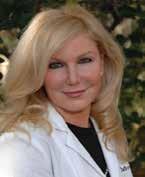
MENU OF SERVICES:
Clinical Acne Treatments
HydraFacials (for ALL skin types)
Oxygen Infusion Facial
European Facials/Microdermabrasion
Botox® (Allergan Cosmetic Grade)
Facial Fillers: Restylane® and Perlane®
IPL Photorejuvenation Packages

Hand Rejuvenation
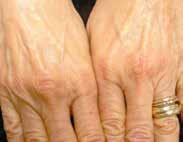

Laser Skin & Wrinkle Reduction Treatments
Skin Tag Removal
Time: 4:00 p.m. - 7:00 p.m. BEFORE AFTER
Date: ursday, April 9th
You will also enjoy 20% OFF all skin care packages and products purchased the night of the event! Enter
From training killer whales to counseling kids, Erica Zeno Robinson, MA, LMHC, registered intern, LC, has covered a lot of ground in her 31 years. Her passion and dedication have earned her the title of Healthy Living’s first “Hometown Hero.” › By
Born in New York but a resident of Ocala since the age of 3, Erica graduated from Belleview High School in 2005 and then earned a degree in psychology from the University of South Florida in 2010.

While still in college, she applied for a position at SeaWorld. Out of more than 300 applicants from around the world, only two were hired. Erica was one.
“Psychology is the preferred degree for a marine animal trainer. It also helped that I was able to hold my breath for an excessive amount of time,” says Erica with a smile.
The three years she spent at SeaWorld proved pivotal when she later decided to use her degree to counsel young children. Today, Erica is the executive director of First StrideZ Counseling, which assists the Marion County community with low-cost specialized counseling services.
“Mental health issues in
Cynthia McFarlandyoung children can appear very di erently than in adults,” explains Erica, noting that, if a child needs help, getting them into treatment early results in a much better outcome by the time they turn 18.
“I loved my life as a killer whale trainer, and it has given me incredible opportunities,” relates Erica. “Building relationships with the whales from the ground up taught
time I have a question about something in my work with children, the answer is back there in my time spent in the pool with the whales.”
For example, a very young child who has been traumatized may not speak but will express themselves using body language. Erica feels better able to perceive this because of her time spent with the marine mammals.
wouldn’t wait to seek help.
“People often put o dealing with it or don’t know what their options are, but I’ve seen people able to lead totally normal lives after getting help,” she notes. “In many cases, mental illness is a chemical imbalance of the brain and medication can save a person’s life.”
me more about patience and respect than any other relationships in my life. Every
Every day, Erica sees anew the need for mental health awareness and wishes she could banish the stigma that surrounds mental health so that people
Another of Erica’s passions is bringing fresh water to communities in Africa, and since 2012, she’s gone on several mission trips with Blessed Trinity Church. At the time of this interview, she was headed to Uganda for another mission trip, where along with the water project, her primary work is with orphans.
That’s just Erica doing what she does—showing up and making a di erence.











Jonathan Clark served 26 years of active duty with the U.S. Navy and qualified as a naval flight o cer, navy diver, U.S. Army parachutist and Special Forces military freefall parachutist. In addition to flying combat medical evacuation missions in Operation Desert Storm with the Marine Corps, Clark worked at NASA from 1997 to 2005 and was a Space Shuttle crew surgeon on six shuttle missions.
Although it might sound futuristic, there are multiple space-themed tourism options currently available. For example, you can experience the sensation of weightlessness in parabolic
flight with Zero G Corp, which occasionally flies out of Central Florida.
“A group based in Jacksonville had proposed using an F-104 Starfighter aircraft to go to the stratosphere, and the Russians currently o er that in a MIG 25,” notes Clark.
“Several stratospheric balloon companies are close to carrying passengers to the stratosphere (near space), including World View Enterprises and Zero2Infinity. Suborbital flight is within a few years of carrying passengers.
Orbital flight is currently only available on the Russian Soyuz via Space Adventures.”
Most people who want to experience space tourism are intrigued by the adventure of it, but the price tag is steep. Be prepared to shell out about $200,000 for a Virgin Galactic flight. (Over 700 people have signed up for suborbital flights with the company.)
We happen to live in an ideal location when it comes to space activities. A number of Florida universities, including the University of Florida and Florida State University, are heavily involved in space research. There’s also ongoing work at the Florida Space Institute at the University of Central Florida and Emery Riddle Aeronautical University, which has astronaut training programs.
“Florida is in a great location to launch into space, with huge protected airspace to launch in the Eastern Test Range and nice scenery for
space tourism, vibrant state and local support, extensive regional aerospace company access and local attractions to supplement the experience,” notes Clark.
In the near future, going into space will likely become more accessible. In Russia, a company known as Space Adventures already o ers astronaut-like training.

“The leading U.S. companies in suborbital space are Blue Origin and Virgin Galactic,” says Clark. “Orbital companies like SpaceX and Boeing are probably going to launch humans by 2020, initially for NASA, but they certainly could do commercial space tourists as well.”

If you’ve ever dreamed of space exploration, you won’t want to miss the October 30 IHMC Evening Lecture Series with Jonathan Clark, MD, MPH, a neurologist, naval flight surgeon and IHMC senior research scientist.
› By Cynthia McFarland
 › By JoAnn Guidry
› By JoAnn Guidry
Good health is key to a good life. But for many, access to health care is problematic. Enter Hope Clinic.
“There is a very underserved population in our community when it comes to health care,” says Cindy Grow, a licensed nurse practitioner who specializes in chronic disease prevention and management. “Many are uninsured, from low income families or homeless. When they get sick, they go to the ER. But most su er from chronic health issues that could be better managed with regular health care visits. This is why Hope Clinic exists.”
Having been on many health care missions in and out of the country, Grow decided to be of service closer to home. Three years ago, she approached Interfaith Emergency Services and volunteered her health care services to their clients. From there, Hope Clinic was born.

“Hope Clinic is a registered free clinic with the Florida Department of Health,” says Grow. “Interfaith allows us to operate the clinic rent free in their building.”
Grow notes that “the people we see have chronic health issues like high blood pressure, high cholesterol, diabetes and
even mental health issues.”
“We evaluate them and provide them with necessary medications and also chronic disease health management skills,” she says.
Open one to three days a week, Hope Clinic sees 40 to 100 people with most returning for multiple visits.
“In addition to Interfaith helping with the more expensive meds, such as insulin, we can usually handle the other medication needs through the $4 or free meds at Walmart and Publix,” says Grow. “We also provide vitamins, eye
glasses, water and many other basic necessities the rest of us take for granted. We even provide bus passes for those patients with no transportation to get to the clinic.”
Hope Clinic is supported through donations of time, equipment, supplies and money. In 2017, Hope Clinic was awarded a $10,000 grant from the City of Ocala. The clinic collaborates with volunteer health care professionals to provide its services. Currently, these include Dr. Kalpesh Solanki (cardiology), Dr. Patrick Acevedo
(oncology/ hematology), Dr. Ashwinn Rumalla (gastroenterology), Dr. Melvin Seek (nephrology), Dr. Don Bovell (acute & primary care) and Ashlee Seek (nurse practitioner).
“We are also fortunate to partner with FreeDOM Clinic and DOCS Imaging,” says Grow. “It truly takes a team e ort to provide those without access to health care a viable way to be healthy. The community of Ocala has continued to show great support in achieving this goal.”
Get involved › HOPE CLINIC › 108 N Pine Street, Ocala › (352) 877-9907 › hopeclinicocala.com


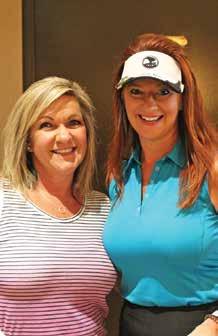

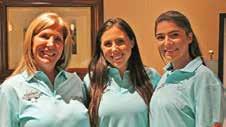
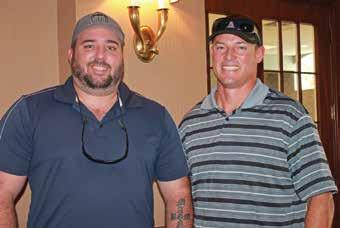



The recent Carli Leutbecher Memorial Golf Tournament raised nearly $14,000 for the Nolan Ryan Hughes College Fund, Interfaith, VOCAL and Feed the Need. Tournament Director Robert Huff thanks the founding sponsor, Sun Kool AC, and the Gold Sponsor, Ocala Horse Properties, for their support, as well as Jenkins Auto Group who generously donated a golf cart that raised $5,000. “A special thanks to the tee sign sponsors, players and volunteers,” says Robert.



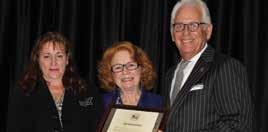

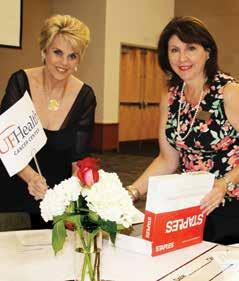
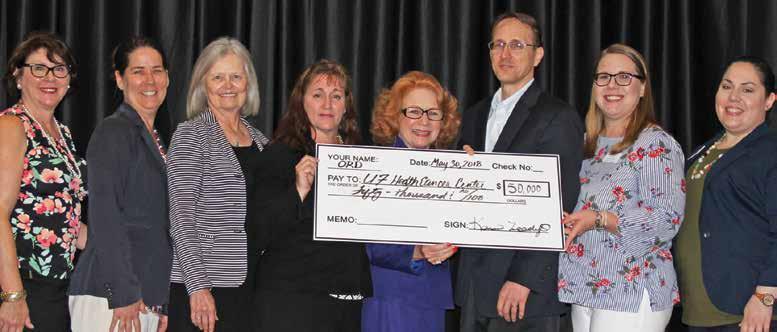

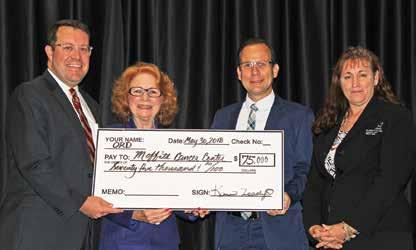


Members of the Ocala Royal Dames and special guests gathered recently at the Klein Center on the College of Central Florida campus for the presentation of checks representing $150,000 in grant funding for cancer research programs. Money funding these grants was raised through the efforts of the Ocala Royal Dames for Cancer Research, Inc.

The 2018 Ocala Style Bridal Showcase, presented by The Lady Jeweler, will be held at the College of Central Florida’s Klein Center on October 24 from 5-8:30pm.
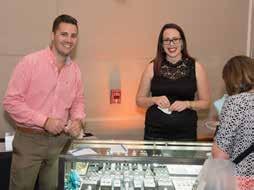 › By Bonnie Kretchik
› By Bonnie Kretchik
It goes without saying, along with something borrowed and something blue, you’ll need something new on your big day as well. And the 2018 Ocala Style Bridal Showcase, presented by The Lady Jeweler, is every bride’s one-stop shop with close to 100 vendors on-site.
Blushing brides wanting to look their best will have the opportunity to peruse numerous cosmetic and skin care vendors while watching models don the latest gown fashions thanks to The Event Warehouse. And we haven’t forgotten about the guys!

Tuxedo Express will be onsite aiding excited grooms in selecting their tuxes.
Not sure what to serve after the I Do’s? Sample until your heart—or stomach!—is content. Food, wine and dessert samples will be provided by several of the many vendors. Make sure to grab an appetizer or hors d’oeuvre from Mojos Grill and Catering, David’s BBQ & Catering, Honey Baked Ham, Todd & Shelly’s Farm Fresh Cafe & Pub and Golden
Ocala, just to name a few. While you’re in the mood to sample, don’t forget to visit
the Island Grove Winery and Indigo Harvest spaces vendors for a glimpse at some of the fabulous wine options available to serve during your big day.
And then there’s the cake. Bakeries and beyond will provide samples, from traditional chocolate to lavish lemon meringue. Make sure to check out Color Sugar’s space for a sweet sample. No gluten? No problem! Sara Fay Farm’s gluten-free options are sweet enough sans the wheat.

No details have been left out of this year’s event.
Everything from florists, photographers and venue options to smaller homebased jewelry businesses and makeup artists will have the opportunity to make an impression on the brides- and grooms-to-be.
This year’s event is generously sponsored by The
Lady Jeweler, Indigo Harvest, Golden Hills Country Club and Rocket Entertainment. For the first 50 brides through the door, special VIP bags filled with samples and other goodies will be waiting, and throughout the evening, attendees will have the opportunity to win some great prizes, including home and kitchen products as well as small appliances, high-end purses and so much more. This can’t-miss event takes place from 5-8:30pm at the College of Central Florida’s Klein Center. Tickets can be purchased in advance online for $10 by visiting ocalastyle.com or at the door for $15. Visit the Ocala Style Facebook page at facebook.com/ocalastyle to stay up to date on all the happenings surrounding the upcoming event. For vendor or sponsorship information, call (352) 732-0073.
Out and about and craving something tasty and healthy? Visit Sushi Bistro on the Square for a delicious selection of rolls, bento boxes, tempura and hibachi o erings. Start with a soup or one of their signature salads, including the avocado or spicy crab salads. Next choose from a variety of perfectly cooked dishes featuring shrimp, chicken, steak or veggies. Make sure to leave room for dessert, though. Our favorite is the fried cheesecake!
18 SE Broadway St., Ocala › (352) 401-7650 › ocalasushibistro.com
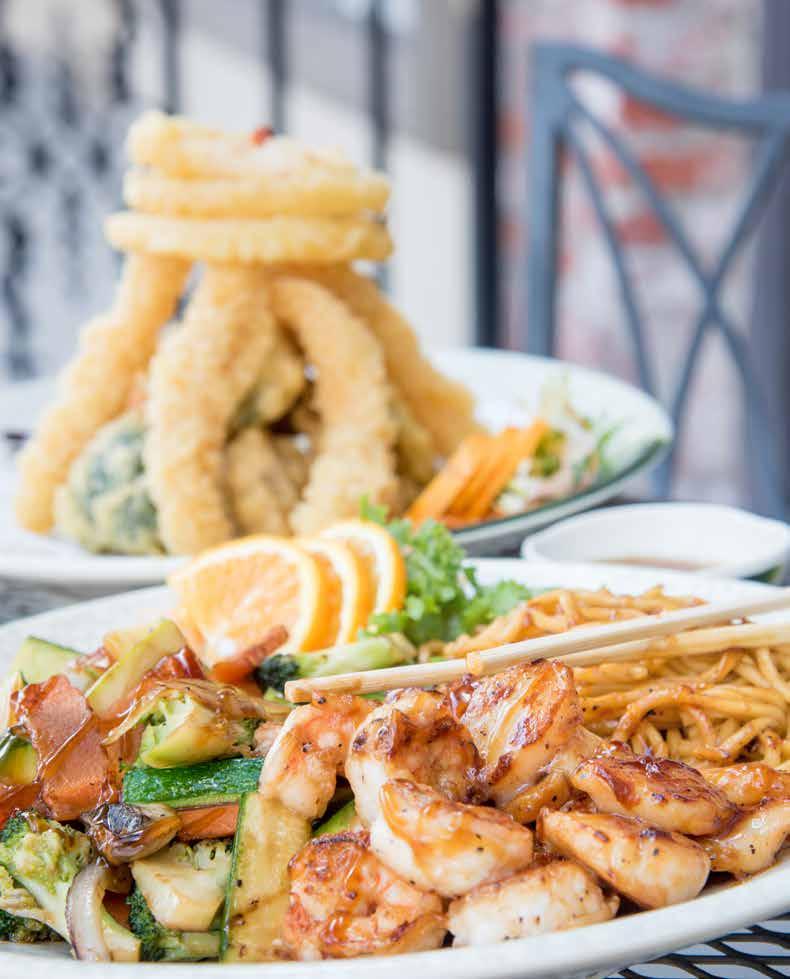
 › Photography by John Jernigan
› Photography by John Jernigan
September is such an “in-between” the seasons month, especially in Florida. Summer is over, and the kiddos are back in school, but it’s still blazing hot outside! In many parts of the country, temperatures are starting to cool down and menus are transitioning to heartier soups and stews, but Floridians are still eating cold salads and reluctant to slave over a hot stove. This month’s recipe is adapted from the inspiring cookbook Cook Beautiful by Athena Calderon. Athena is the superstar blogger behind Eyeswoon, an inspiring blog featuring delicious food, gorgeous photography, design, fashion and overall good taste. This month’s recipe is the perfect dish for this time of year, combining root vegetables and citrus fruit with a tangy yogurt dressing. It is easy to make, refreshing, light and will look beautiful on your September table. We love it served alongside a grilled lamb chop, chicken or fish.

Adapted from Cook Beautiful, by Athena Calderon
4 medium beets (red and golden)
2 tbsp extra virgin olive oil, plus extra for drizzling
Salt and cracked pepper
4 or 5 sprigs of fresh thyme
1⁄4 cup hazelnuts
2 blood oranges and one large ruby red grapefruit
1 small shallot, finely chopped
2 tbsp red wine vinegar, or vinegar of your choice
1 cup Greek yogurt
4 or 5 sprigs fresh herbs
rsvprobin.com
Preheat oven to 425°F. › Place beets in the center of a large piece of foil. › Drizzle them with olive oil; season with salt and pepper. › Add a few sprigs of thyme, and tightly seal the foil around the beets to make a packet. › Place beets on a rimmed baking sheet, and bake for approximately 1 hour. › Let cool, peel the beets and set aside. (This can be done ahead of time.) › Toast hazelnuts on a baking sheet for approximately 4-6 minuets. (Be careful not to burn!) › Rub toasted nuts in a kitchen towel to remove the skin, and roughly chop. › Squeeze juice from 1/2 of an orange into a medium bowl, add the chopped shallot and vinegar, season with salt and pepper and whisk in the olive oil. › Remove pith and peel from the remaining oranges and grapefruit, and slice them crosswise into 1/4-inch rounds. › Cut the beets into wedges. › Season yogurt with salt and pepper. › On a platter, arrange the orange slices and beet wedges over the yogurt, spooning some of the dressing over the top. › Sprinkle with chopped hazelnuts and fresh tarragon sprigs.




















For cancer survivors, eating a quality, well-rounded diet could significantly lower their risk of dying from cancer. A University of Florida study has found that, compared with survivors who ate poorly, cancer survivors who maintained a balanced diet faced a decreased mortality risk. The study based a balanced diet on one that was nutrient-dense and consisted of fruits and vegetables, whole grains, proteins and dairy.

The study, conducted by UF researchers, utilized health data obtained between 1988 and 1994 by the National Center for Health Statistics. Researchers combed through the data and analyzed the participants, 1,200 of which were cancer survivors. Having identified these survivors, the team moved on to assess their diets. Investigators turned to the Healthy Eating Index,
which measures diet quality, and scored individuals based on how well they conformed to the U.S. Department of Agriculture’s Dietary Guidelines for Americans. Their next step was to follow up on the participants by consulting the records in the National Center for Health Statistics
Linked Mortality Files all the way through 2011. Researchers worked to find a link to associate cancer survivors’ diets with their deaths, whether that was any cause or specifically cancer related. They determined that cancer survivors were 65 percent less likely to die from cancer when they scored high on the Healthy Eating Index. Though the study indicates correlation between diet and risk of death, researchers cite the study as initial evidence that needs further study to prove direct causation. Still,
65%
changing your diet to a more healthful, varied range of food will not have adverse e ects. Here’s how to do it.
› Aim for an inclusive diet, and eat different foods in moderation. This method is known as the total diet approach.
› Focus on vegetables and fruits, with at least one serving every day of whole fruits and a mix of different veggies.
› Vary the proteins you eat, and
avoid added sugars, sodium and saturated fat.
› Choose fat-free milk, or switch to dairy-free alternatives such as almond milk.
Studies like the University of Florida’s public health research are important because they promote the knowledge and understanding of the general public. By being conscious of what you consume, you can improve your overall health in the short-term and in the future.
Small changes and a little extra consideration when it comes to your diet could make a big di erence in life-long health
.
›
By Lisset Lanza
Every year, the Environmental Working Group releases an updated guide to purchasing produce. It ranks the fruits and veggies found with the most amount of pesticides in order of contamination, urging shoppers to consider buying organic when possible for the items on this list. The produce is washed and peeled when applicable, before being tested to determine which contain the highest concentrations of healthharming chemicals.
These leafy greens contained substantially high amounts of permethrin, an antiparasite chemical. A total of 97 percent of spinach samples tested contained residual pesticides. This large number, along with the presence of the neurotoxic insecticide found on the vegetables, explains why spinach holds the second-place spot on the list.

Almost 94 percent of all nectarine samples tested contained at least two pesticides. In one particular sample, the fruits contained the residues of 15 identifiable pesticides.

Apples’ nutritional properties and sweet taste make it a supermarket staple. Unfortunately, 90 percent of apples contained residual pesticides, 80 percent of which contained a pesticide known as diphenylamine (DPA). The chemical, which is banned in Europe for health and safety reasons, can still be found in the United States. In order to protect and preserve apples after harvesting, DPA is used in addition to a waxy coating as the fruit is put in storage.
On cherry samples tested, an average of five pesticides were found, with 30 percent of cherry samples containing a chemical called iprodione. Although it’s still used in the United State, that chemical is no longer allowed in Europe.
Over half of conventionally grown pears contained five or more pesticide residues, several of which were in high concentrations. Among these pesticides were fungicides and insecticides.
One tomato sample showed evidence of 15 total pesticides and breakdown products. The average conventionally grown tomato tested positive for four pesticides.
A little over 95 percent of conventional celery contained pesticides, with one sample study finding 13 pesticides on the vegetable.

By weight, potatoes beat out every other crop’s residual pesticides. Making up the bulk of potatoes’ pesticides is chlorpropham, an herbicide used to control weeds.
Although sweet bell peppers tend to show fewer pesticide residues than any other food on the Dirty Dozen list, the pesticides found can be more toxic to human health. Pesticide residue was found on nearly 90 percent of sweet bell pepper samples.

Coming in at No. 1, strawberries are 2018’s dirtiest produce. Testing found that one-third of the total number of samples contained more than 10 pesticides left on the berries. On one batch of strawberries, 22 pesticide residues were recorded. The chemical agents left behind even after washing have shown the astounding amount of pesticide treatments strawberries receive.

Over 96 percent of grapes contained pesticide residues, with an average of five pesticides found on grapes.
Juicy and fragrant, peaches’ signature soft and fuzzy outer layer may be the reason why more than 99 percent of the fruits’ samples contained pesticides. Conventional peaches that were tested contained an average of four detectable pesticide residues.
For some of us, running is a dreaded activity reserved strictly for when something is chasing us. For others who strive to improve their cholesterol, lung function and immune system, running is an easy beginner’s sport to add to their weekly routine.
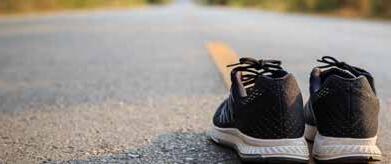
 › By Laurel Gillum
› By Laurel Gillum
Follow these tips to avoid novice mistakes when it comes to your newfound cardio exercise. Usain Bolt, we’re coming for your record.
It’s important that you choose the right pair of shoes for your run. Although it’s not necessary to spend a fortune on the trendiest kicks, you’ll want to make sure to find a shoe that will lend support. Try jogging around the store before purchasing. A good sneaker will come equipped with room for your toes, an arch and just the right amount of flexibility.
Take a break. Slow and steady wins the race they say. If you experience soreness during a run, don’t feel ashamed to take five and stretch. Over-working your bones and muscles will only set you behind in the long run (no pun intended). Take a few days for your body to recuperate between workouts.
Mix it up. Although running is a great way to get your blood pumping, it is vital to try other forms of exercise as well. This alleviates some of the pressure you may experience in the same few muscles while strengthening others. Using this method significantly decreases your risk of injury.
Association, it is recommended to drink 6 to 12 ounces of water every 15 to 20 minutes during a run. It’s also recommended that runners drink about 16 ounces of water two hours before a run and about 8 to 16 ounces 15 minutes after.

Set goals. After some time of consistent activity, your stride should physically and visually improve. In the meantime, set reasonable goals such as a weekly mileage you want to meet or the time in which you want to do so. Remember to never compare your progress to that of others!
Check out these trails perfect for running near you:
› Belleview-Santos
Trailhead 3080 SE 80th St., Ocala
Stay hydrated. Prevention of dehydration is also the prevention of fatigue. Because endurance is key, according to the American Dietetic
› Silver River Trail 5656 E Silver Springs Blvd., Silver Springs
› Cross Florida Greenway Trail 8282 SE Highway 314, Ocala
Treatment of Common Ailments such as Bunions, Hammertoes, Heel Pain, Fractures, Sprains, Athlete’s Foot, Neuromas, Tendonitis • Ankle Arthroscopy • Laser Foot Surgery Sports Related Injuries • Children’s Foot Care • Custom Orthotics



PROUDLY WELCOMES ANDREW FRANKLIN


Dr. Andrew Franklin is from Essex, UK. He earned a 1st class master’s degree in chemistry from the University of Exeter (UK) in 2002 and a PH.D. in organic chemistry from the University of Sheffield (UK) in 2007. From 2007-2010 he performed post-doctoral research in organometallic chemistry at Florida State University, Tallahassee, FL. Dr. Franklin then attended Kent State University School of Podiatric Medicine in Cleveland, OH, receiving a Doctor of Podiatric Medicine degree in 2014 and then completed a three-year foot and ankle podiatric medicine and surgery residency at Mercy Health Foot and Ankle Residency, Cleveland, OH. Dr. Franklin is ABFAS board forefoot and rearfoot qualified and enjoys practicing in all areas of podiatry, including diabetic preventive care, wound care and forefoot and rearfoot surgery. He is married with two young boys and looks forward to becoming more actively involved in our community. In his spare time, he enjoys spending time with his family, running, reading and cooking.


Owning a home may be the American dream, but it comes with never-ending upkeep and expenses. For Laura Siedel, walking away from that was a huge relief.
When she moved to The Estates at Hawthorne Village of Ocala this past March, no longer having homeowner responsibilities was like a weight lifted o her shoulders.
“Been there, done that!” laughs Laura. “I love getting the mail and knowing there won’t be bills for home insurance, taxes, pest control or any of those things. This is perfect for me. I don’t have to do anything I don’t want to do.”
Originally from Illinois, Laura and her husband moved to Plantation, Florida, in 1979. Widowed for 19 years now, Laura
moved to Ocala to be close to her son who lives here. Her other two children and their families live in Pompano, Florida, and Minnesota. Ten of her 16 grandchildren live in Ocala, and she sees them regularly.
“My son found The Estates at Hawthorne Village. I came for a tour and talked to a couple of the tenants, who told me they love living at The Estates. I fell in love with it, too,” relates Laura, who selected a third-floor studio-style apartment home. “When I had that great big house, I was only living in a small part of it, so adjusting to living in a studio wasn’t hard at all. I only moved the pieces of furniture I wanted and needed.”
Being free from cooking and household chores was also a breath of fresh air.
“I don’t miss cooking! I think the food is marvelous and the sta is wonderful,” says Laura. “They go out of their way to keep you happy and content.”
For many people turning 85, it might be hard to make new friends, but Laura was delighted to find that hasn’t been the case at her new home at The Estates at Hawthorne Village.

“The people who live here are really friendly,” she says, “and there’s a lot of fun entertainment and social activities. It’s a wonderful place; I’m very glad I decided to make the move here.”
When she’s not involved in group activities, Laura enjoys word search books and keeping up with friends and families on Facebook with her computer and iPhone, pleased that she has free Wi-Fi included in her monthly rent. She still has her car and drives most places, even though a shuttle is available.
Originally from Wisconsin (“Go, Pack, Go!”), Kathleen Back and her late husband wintered in Florida for several years before moving permanently in 1997.
A widow since December 2009, Kathleen later lived with a domestic partner, but after he passed in 2015, she began looking for the right place for herself and her cat, Okie.
That’s when she found The Estates at Hawthorne Village.
“I really liked the fact that everything here is contained in one building. You don’t have to go to other buildings for dining or to exercise. I didn’t want to have to buy a golf cart just to get around,” says Kathleen, 83, adding that it was also important to find a place where she could have a pet, as she didn’t want to give up Okie.
Over the course of a year, Kathleen visited The Estates at Hawthorne Village multiple times and attended various events, so when she actually moved in May 2018, she had already developed friendships with several of the tenants.

work on those as well. During football season, she’ll be cheering on the Packers on the big screen TV in her lovely apartment home.
Kathleen still drives and enjoys the opportunity to visit her daughter’s family nearby. Her other two children and their families live in Valrico, Florida, and Wisconsin. She has eight grandchildren and 14 great-grandchildren.
“I’m happy here,” says Kathleen. “There’s something to do all the time, but the greatest thing is the people. The tenants, as well as the entire sta , are so pleasant.”

Hawthorne Village of Ocala is a not-for-profit, full-service retirement community, conveniently located near Paddock Mall, major health care providers and a variety of cultural and historical venues. The Estates of Hawthorne Village o ers exquisite apartment homes for the independent retiree who seeks an active lifestyle with an all-inclusive monthly rent. Worry-free and maintenance-free living awaits you at The Estates, as weekly housekeeping and linen service, two restaurant-style meals per day, transportation to medical appointments and scheduled lifeenrichment activities are just a sampling of what is available to the tenants. The Inn at Hawthorne Village of Ocala is a lovely, homelike setting for those individuals who need assistance with daily self-care in a supportive and attractive environment.
As part of a full-service retirement community, Hawthorne Village of Ocala provides a full spectrum of care to meet all of your health care needs, including a state-of-the-art inpatient and outpatient Bounce Back Rehab and skilled nursing—all of this, on one beautifully manicured and easily accessible campus.

“For me, coming here was very deliberate,” says Kathleen, who chose a beautiful, two-bedroom, one-bath apartment home. “I like having my co ee on the screen-enclosed patio in the mornings,” she adds, noting that Okie also appreciates this private outdoor space.
Kathleen was delighted with the opportunity to live in such a sizeable apartment home, as well as all the amenities included in the monthly rent. She studied the floor plan carefully to design the perfect layout of her furniture.
“That let me have a plan of exactly what I desired and needed to bring with me,” she says.
Kathleen belongs to The Book Club, which meets weekly in the handsome library of The Estates. She enjoys playing bingo twice a week and wouldn’t miss the fellowship of the scrumptious Ice Cream Social every Sunday afternoon. There is always a jigsaw puzzle in progress down the hall, and Kathleen has been known to





 BY NICK STEELE
BY NICK STEELE
procedures. There has also been a shift in attitude over the last few years, allowing many of us to feel more comfortable discussing our interest in exploring the various options.
“The minimally invasive market has grown something like four or five times faster than plastic surgery procedures,” confirms Doctor Navinderdeep S. Nijher of Ocala Plastic Surgery. “What we have found is that people are starting with minimally invasive procedures much younger. If you start at a younger age, it creates a maintenance e ect, so you can sort of hold back the aging process for a little bit longer. With older patients, who have not done injectables, the minimally invasive treatments may not be as e ective, and they may be a better candidate for surgery. Our largest segment for minimally invasive is definitely a younger patient.”
Of the top-five minimally invasive procedures, Botulinum Toxin Type A topped the list with a staggering 7.23 million procedures last year. The public, of course, knows it better as Botox.

Let’s face it, who among us has not looked in the mirror and thought about those couple of changes that would make us feel more confident or attractive. Statistics reveal that an increasing number of Americans are either curious about the options or taking the plunge where minimally invasive cosmetic procedures are concerned. Advancing technologies and innovative treatments may seem like a quick fix to some, but many see these procedures as a way to positively impact their appearance and alleviate body-image dissatisfaction.
And the numbers don’t lie. Since the year 2000, minimally invasive cosmetic procedures have increased nearly 200
percent, according to the American Society of Plastic Surgeons (ASPS). Last year, there were 15.7 million minimally invasive cosmetic procedures performed in the United States. In fact, minimally invasive cosmetic procedures actually grew at a slightly higher rate than surgical
“The formulation of Botox has not changed since it came out, but how we use Botox definitely changed. When it first came out, we wanted to literally freeze somebody’s face to prevent wrinkles, but we learned that it was not resulting in a healthy, natural look,” says Dr. Ashley
Cauthen of MidState Skin Institute, who also reports that Botox is among the most requested procedures at her cosmetic and clinical dermatology practice. “What has changed is how we’re using it, the amount of units we use and where on the face we are placing it. We have learned, over the years, how to use it to give you a good, youthful appearance.”
But do we really feel good about having any toxin injected into our bodies?
“Botox and fillers have been around for [many] years. A lot of people are unaware that Botox is the purified protein from the neurotoxin. It takes out the good part, and we inject that,” explains Dr. Tina Chandra, a cosmetic and neuromuscular dentist at Chandra Smile Designs, who added Botox and fillers to her treatment o erings 15 years ago when her patients expressed an interest.
“Often, when we are talking about Botox, we may actually be talking about any of the products in this category, including Xeomin or Dysport,” says Dr. Cauthen. “It’s just that Botox has so much brand recognition that patients know the name. They all accomplish the same thing.”
So what is the di erence between Botox, Xeomin and Dysport, the three leaders in the category? Xeomin is known as the “naked injectable,” meaning that it contains only one ingredient: botulinum toxin A and no additives.
“Xeomin is the most purified form of neurotoxin. There is not extra binding protein,” explains Dr. Cauthen. “So if you have a patient who wants to get their toes wet with some cosmetic procedures, but really prefers to be more natural in the substances they use and take, then Xeomin may be a good option for them. It’s also a good option for younger patients.”
One of the most common misconceptions about these sorts of procedures is that they represent a quick fix. But all the providers we spoke to say that once you begin these treatments, you will generally need to keep going back for regular treatments to maintain the results you achieved.
“The reality with minimally invasive procedures, whether it is Botox or fillers, is that they are not permanent,” says Dr. Nijher. “The Botox will last anywhere from three


“Men don’t want to get left behind in the game anymore. Most of the men who come in are doing neurotoxins, Botox, Dysport or Xeomin. Men have also jumped on the filler bandwagon.” — DR. CAUTHEN
to six months; the fillers will generally last nine months to a year. Someone who starts in their 30s will be on a maintenance regimen, and they probably won’t need a ton of product. But someone who comes in for the first time to have something done when they’re 45 or 50 years old will require a lot more product just to give them a decent result. Then it is all about maintaining it.”
Fillers took second place in the rankings, no doubt with some help from Katy Perry, who revealed to the world that she gets under eye filler injections to treat her dark circles.
“Placing a filler under the eye really rejuvenates the face and brightens it,” says Dr Cauthen.
“Almost every single patient is a good candidate for that, to some extent. But they might not even know that’s an option.”
Lasers are another option for those who don’t like needles or the idea of being injected.
“Lasers have been very popular for the last 10 years. There are many di erent levels of lasers out there; some penetrate
the surface of the skin, and some penetrate hard tissue like teeth and bone,” says Dr. Chandra. “As a dentist, one of the primary reasons I got into using lasers was to be able to perform dentistry faster and without the use of needles. When that high-energy beam penetrates that enamel, the nerve stays calm. I rarely have to give patients a shot anymore for something like a simple filling.
“But over the last five or so years, that technique has also been perfected on the skin,” she adds. “As we age, we lose that collagen elasticity in our skin. When you lose that elasticity, the cells just break down. So what the laser light does on the surface, but without touching the skin at all, is to tell the cells to regenerate and rebuild that collagen that you have lost. But with this kind of resurfacing, it won’t happen over a few sessions. You may have to have three to five sessions, depending on how fine or deep the wrinkles are. To get the outcome you want, you need to do it repetitively (Treatments every 21 days is ideal.) to tell those cells to wake up and regenerate again. It’s not going to make your skin baby-butt smooth, but it will make your skin look less lined and wrinkled. It’s your own body restoring its skin. There is no recovery time. You can go right back to work, and nobody will know you had anything done.”
Another treatment that is keeping Dr. Nijher busy is CoolSculpting.
“It’s primarily for patients who have fat deposits in the subcutaneous area (soft, pliable fat that lies directly under the skin),” he says. “You are hooked up to the CoolSculpting device, which creates a suction and freezes the fat. Once frozen, the fat cells essentially die, and the body gets rid of them. It is great for love handles, the abdominal and the flank areas. But you can use it pretty much anywhere on the body that you have focal deposits of fat. It is not for areas where you have extra skin that may need to be excised.”
Ah yes, the dreaded extra skin. Take heart because Nilam Patel, CCE, CME, clinical esthetician, electrologist,
hyperpigmentation specialist at Pushti Brows and Skin Therapy, can help.
“The most popular procedure we do here is skin tightening,” Patel explains. “That can be anywhere on the body, from the face to the stomach area. We can also handle loose, sagging skin and stretch marks due to fast and excessive weight loss. Another popular procedure is cellulite reduction.”
Although Patel sees mostly female clients, she notes that she has a number of men who come in for facials, hair removal and fat reduction.
“Men don’t want to get left behind in the game anymore. Most of the men who come in are doing neurotoxins, Botox, Dysport or Xeomin. Men have also jumped on the filler bandwagon,” says Dr. Cauthen. “They tend to get hollow in di erent places than women, and the way you inject them is di erent, too. Because the last thing you want to do is feminize a man’s face.”
Dr. Nijher has observed that men tend to gravitate toward minimally invasive treatments like Botox, Kybella and CoolSculpting.


“We’ve seen a huge uptick in the number of men getting procedures,” he says. “Kybella tends to work well on men. We inject into the neck area to get rid of some fat under the chin. That helps us define that area.”
An issue that straddles the line between cosmetic and medical is the appearance of unsightly varicose veins and spider veins. Dr. Brittany Nagy of Lake Medical Imaging warns that besides being unsightly, these veins can represent something serious.
“Many people will start having heaviness or pain in their legs or swelling in their ankles,” she says. “A very common cause is from reflux, meaning the blood is not going toward the heart as it should, because it is pooling into the legs because the valves in that vein are not working properly.”
Given all the great information out there on various procedures and practitioners, do some research on both before deciding on anything. Schedule a consultation. Ask about credentials like board certification. And don’t be afraid to ask questions.
“People are starting with minimally invasive procedures much younger. If you start at a younger age, it creates a maintenance e ect, so you can sort of hold back the aging process for a little bit longer. — DR. NAVINDERDEEP S. NIJHER
Your set of hand weights is gathering dust under the television. Your new walking shoes are still in the box. You had pizza for dinner twice this week.
OK. Enough judgment and self-trash talk. Forgive yourself. There’s still plenty of time left in 2018 to establish some healthy habits and see the results this year. For down-to-earth advice, we turned to Christal Churchill, an American College of Sports Medicine (ACSM)certified personal trainer and nutrition expert at Zone Health and Fitness in Ocala. Her years as a trainer and background in nutrition have helped many clients achieve success by
linking fitness with a healthy eating plan.
Christal shared common sense advice to making over your eating habits and a realistic exercise program that can be done at home without specialized equipment.
“Fitness really begins between your ears,” says Christal, who clearly understands the role psychology plays in the whole weight loss/fi tness quest. “It all starts in your head; your thoughts are so important to your overall health and well-being.”
She reminds clients not to be obsessed with weight. It’s just a number and doesn’t tell you how much muscle you’ve
gained. Remember that muscle weighs more than fat, and adding that muscle is key to your body functioning as it was designed to do.
“As you increase muscle, your body fat goes down, and when you build muscle, you burn more fat—even just sitting,” Christal explains. “One pound of muscle burns 50 calories at rest, so 10 pounds of muscle will burn 500 calories at rest. If you needed incentive to gain muscle, here it is!”
You’ve likely read those bizarre stories online: “I Ate Nothing But Twinkies for a Month and Lost 15 Pounds” or “How to Lose Weight on a Fast Food
Diet.” Although this might make you feel better about your own eating habits, let’s be honest here. To make real progress, you can’t just start working out. You also need to address the way you eat.
“Food is 85 percent of your body changing, so you need a healthy lifestyle in the kitchen,” says Christal. “You will always get results from exercise, but it’s when you combine exercise with nutrition that you get optimal results.”
For starters, Christal recommends writing down everything you eat for a week. This will help you identify patterns, such as stress or boredom eating, and start to make changes.
one month.
By Cynthia McFarlandThere are countless diet plans and cookbooks for healthy eating, but rather than adhere to a specific list of foods to eat (some of which you probably wouldn’t like), start incorporating basic changes in how you eat. Here’s what a healthy balanced meal should look like:
• Half: vegetables (primarily green ones)
• One-quarter: low-fat protein (skinless chicken breast, fish, etc.)

• One-quarter: complex carbohydrates (brown rice, sweet potato, spaghetti squash, chickpeas, etc.)
“Anything that can fit in your palm is about 4 ounces, which is a good portion of protein for both men and women to stick with,” says Christal. “A closed fist size is the amount of carbs you should have per day. Fill the rest of your plate with veggies; green ones are especially good for you and are considered ‘free’ foods.”
But wait, aren’t we supposed to load up on fruit, too?
“Even though it’s natural, fruit is still sugar, so go easy on it and preferably stick with berries, as they’re loaded with antioxidants,” says Christal, who advises limiting fruit to one serving a day, making it a good choice for dessert.
Christal adds that many
Creating a simple fitness and nutrition plan can change your body—and your life, in just
people only eat twice a day, when, ideally, they should have at least four to fi ve small meals daily.
“The best analogy is to think of your body as a machine, which loses production when it has to stop and start your metabolism,” she explains. “Keep it fueled with small, healthy meals throughout the day. Even if you’re trying to lose weight, you want to keep eating.”
Soda manufacturers have done a brilliant job marketing products that have no
Use
• Perform the test using a phrase that takes about 20 to 30 seconds to say, such as the Pledge of Allegiance. If you can talk comfortably while exercising, your body is utilizing fat as a primary source of fuel. Once it becomes di cult to talk, carbohydrates have become the primary source of fuel for the activity.
nutritional value whatsoever, and many Americans are hooked. If you’re one of them, start gradually weaning yourself o and make it a point to hydrate yourself with water.
Adequate hydration and sleep are crucial to health, yet many people skimp on both.
Adults age 18 to 64 should get seven to nine hours of sleep per night. (Those 65 and older can get by with seven to eight.)
The old “eight glasses of water a day” isn’t necessarily
If you don’t have a heart rate monitor, you can also get a good measure of the level of your physical activity by talking.
• If you’re able to converse regularly, your activity level is low.
• If it’s still possible to talk, but harder, you’re at a moderate level.
• Once you’re not able to talk well at all, you’ve hit a high level.
correct, as the amount you need is based on your individual weight. Here’s a general formula to determine how much water you need daily: Drink half your body weight in ounces per day. (For example, if you weigh 160 pounds, you need a minimum of 80 ounces of water daily.)
Christal recommends buying a container that holds as much water as you need and drink it throughout the day. She notes that if your body isn’t used to getting the
water it needs, you may feel a little bloated at fi rst and have to urinate more frequently, but don’t worry, your body will adjust in a week or two.

The color of your urine is a good barometer as to whether or not you’re drinking enough water. If you’re adequately hydrated, it should be clear or very pale yellow.
If you haven’t been physically active at all, start with walking 20 to 30 minutes a day. The idea is to create a routine. Then, in a couple weeks, you can ease into doing the exercises in the program.
When you’re walking (or doing any physical activity), putting your hands up over your head significantly increases the level of exertion. It’s an easy way to make your body work harder.
Pick up a set of resistance bands (start with “light”), and begin using them for simple movements and stretches. Unlike free weights, this form of strength training requires you to control muscle contraction the entire time.

Adequate hydration and sleep are crucial to health, yet many people skimp on both.Christal Churchill
Follow this routine and you’ll begin to feel better and see results in just a few weeks. Core exercises help flatten the tummy, while also developing strength and definition in the hips and thighs. Christal recommends: bird dog, side plank, front plank, glute bridge and crunches. (Ask a personal trainer to show you how to properly perform exercises or look them up online.)
NUTRITION:
• Keep track of every single thing you eat.
• Drink water (not sugar-added beverages) to quench thirst.
• If you drink soda, start cutting back.
• Increase the amount of vegetables you’re eating.
FITNESS:
NUTRITION:
• Reward yourself (not with food!) for being consistent with your healthy eating plan. Buy yourself a new co ee mug, piece of workout gear, etc.
• Try di erent complex carb options (substitute spaghetti squash or zucchini spirals for pasta, etc.).
• Don’t have more than two protein or meal replacement shakes a day; you need actual food, not just protein.
NUTRITION:
Choose three alternating days to exercise. Perform one set (12 repetitions) of each core region exercise. Rest at least 30 seconds before moving on to the next exercise. Walk 15 minutes continuously three days this week, using a pace where it’s comfortable to hold a conversation.
FITNESS:
Again, choose three alternating days. You’ll be doing the exercises as a circuit, completing a single set (15 reps) of each, resting between each exercise for 15 seconds and then continuing. Perform the entire circuit (all exercises) twice so you do two sets of each exercise. Walk for 20 minutes continuously, a minimum of three di erent days, using a pace where it’s comfortable to hold a conversation.
• Make it a point not to eat closer than two hours before bedtime.
• Continue cutting back on soda (if applicable).
• Follow the healthy balanced plate amounts/types of food.
FITNESS:
NUTRITION:
• Continue making healthy food choices.
• Fine tune those choices by swapping healthier items (for

Again, choose three alternating days, and progress to two sets (increase to 15 reps each) of each exercise, resting for 30 seconds between each set. Complete both sets before moving on to the next exercise. Walk for 15 minutes continuously, a minimum of four di erent times, using a pace where it’s comfortable to hold a conversation.
FITNESS:
Continue to choose three alternating days. Your goal is to complete the entire circuit before taking a rest interval of one minute. If possible, repeat the circuit three times. Walk for 20 minutes continuously, a minimum of four di erent days, using a pace where it’s comfortable to


Amid a sea of flailing appendages and twisted bodies, all frantically fighting for position in either blocking or opening a lane for the incoming corner kick, the great Cristiano Ronaldo sneaks into a small gap in direct line with the vector of the dappled ball.
Transforming himself into a human projectile, Ronaldo springs head first and nearly parallel to the ground, striking the inbound missile with his neurocranium’s left parietal. The ricochet results in the ball sailing past all defenders and into the back of the net as the crowd roars its approval and astonishment.
The play helps Portugal eliminate Morocco from the 2018 World Cup and will further inspire the dreams of millions of children around the world.
Ronaldo’s header, as a testimony to his own brilliance and uncommon athleticism, stands as just another day at the o ce for one of the world’s greatest soccer players. Ronaldo’s header also represents a simple fact of how soccer has always been played and perhaps always will, especially at the highest levels.
The good news is that millions of inspired children immediately raced outside to emulate Ronaldo’s acrobatics.
The bad news is that millions of inspired children immediately raced outside to emulate Ronaldo’s acrobatics.
And therein lies the conundrum for youth soccer in particular but organized youth sports in general. The manner in which the elites ply their trades at the highest levels of sport may enthrall the masses but may also encourage play that puts growing brains at risk.
Greater concerns over head injuries in sports have prompted a re-evaluation of our beloved pastimes and even a movement to alter their rules and the very manners in which they are played.
In the last decade, terms such as CTE (chronic traumatic encephalopathy) have become prominent in the lexicon of sport, especially contact sports such as football and even soccer and lacrosse. At all levels, the notion of concussion seems to be taken much more seriously than 20 years ago.

“We used to just think, ‘oh, you got your bell rung—shake it o and get back out there,’” says Vince Arnold, president of the Marion County Youth Football League. “But we know more about head injuries

these days and see how serious these injuries need to be taken.”
According to the Centers for Disease Control and Prevention, the number of reported concussions in organized youth sports has doubled in the past 10 years, and emergency room visits for concussions in children ages 8 to 13 has doubled.

Not surprisingly, football earns the dubious distinction as leading all youth sports in terms of concussion rates among competitors, followed by ice hockey, soccer and lacrosse.

The most recent statistics compiled by Head Case Company Sports Concussion show that in football there were 64 to 76 concussions per 100,000 exposures (one exposure being an organized practice or game). In ice hockey, the number was 54, while in boys lacrosse 40 and girls soccer 33.
That football, with bodies colliding on every play, remains the highest risk is of little surprise to anyone, and the past decade has seen many rules changes in an attempt to minimize those risks. The concussion risks in soccer may seem a bit more subtle, but they are garnering much scrutiny recently.
A recent study published in Neurology claims that players who headed an average of 125 balls over two weeks were three times more vulnerable to concussion than players who headed less than four in that same time period.
Would the answer be to make heading illegal in soccer? While Ronaldo continues to dazzle crowds with header goals, it’s not ever likely to happen at the highest levels, but at the youth level, we are already there.
In 2015, the U.S. Soccer Federation, in response to a class-action lawsuit from parents of youth soccer players, issued new guidelines banning players under age 10 from heading the ball in practices and games. That rule is being taken seriously by local leagues.
“Heading is a critical part of the game,” says Josh Scroggie, president of Big Sun Youth Soccer League and a former Ocala Star-Banner Soccer Player of the Year. “The first year, the rule was implemented was extremely di cult. Those kids had been used to doing it, and now you’re telling them they can’t do it anymore. At first there was the thought that, ‘Oh, this is the end of soccer as we know it,’ but it really hasn’t been that big of a deal.”
For Scroggie and others, there was a fear that banning headers would lead to a greater amount of high kicks that can result in injury, but what may be happening is a better focus on developing other vital skills in the sport.
“At fi rst, trust me, all the coaches were opposed (to the rule) and thought it was ridiculous,” says Scroggie. “But, like everything else, as time goes on, you accept it. It’s at a developmental stage for the kids—they’re not too concerned about the loss of game tactics. It’s hard to argue with it.”
For one local physician, the new rule banning headers is a welcome one. Dr. Howard Rogers works in the Children’s Emergency Department at Florida Hospital Ocala, and he has seen his share of youth sports injuries.
“The rule makes sense,” Rogers says. “I would say [heading] can be a relatively
dangerous thing based on several factors, such as how fast the ball is coming in. I would support, from a medical perspective, the notion that heading the ball increases the risk for head injury, and it’s not worth it for a kid under 13 to try and develop that skill.”
For BSYSL, taking on the threat of head injuries means more than just banning headers for the young players but also instituting necessary protocols in terms of head injuries. For starters, one cannot
“People need to understand the fact that the game of football is looking different because they’re trying to prevent head injuries” - DR. HOWARD ROGERS
become a certified coach or manager until a concussion protocol test administered by the Florida Youth Soccer Association has been passed.
“We have our administrators do it as well,” Scroggie says. “To be on the board, you have to take it.”
BSYSL also follows the guidelines set forth by the CDC’s Heads Up Concussion program, which o ers training to coaches and trainers. At tournaments, there is always at least one trainer on hand. Players who sustain a head injury or are even suspected of such are immediately removed from the game or practice and undergo evaluation.
Protocols are similar in the MCYFL, which last season boasted of over 1,200 participants. Coaches must be certified in teaching proper tackling techniques in which the head may not be used to lead or be the target. Penalties are assessed for “targeting” defenseless players in an e ort to change the culture of the game.
“Teaching the proper, safe techniques is important at this level,” Arnold said. “The game of football is going to look di erent in the future, but I think it’s for the better.”
Dr. Rogers certainly agrees with that sentiment. He played football in high
school and college and considers himself a “purist” in terms of how the game is played, but he welcomes changes that should make the sport safer.
“Football is a game of violent contact— it’s not a contact sport, it’s a collision sport,” Rogers said. “The challenge for the football purist is to fi gure out how to change the rules of the game but also preserve the game. The question is, ‘Are we preserving young peoples’ brains?’ People need to understand the fact that the game of football is looking di erent because they’re trying to prevent head injuries.”
So what is the world coming to? Young soccer players can no longer head the ball? Hard tackles draw penalty flags in football?
The concussion culture in sports will change the way sports look in the future, and it starts with the implementation of change at the level of organized youth leagues. MCYFL and BSYSL have certainly embraced changes, but no clear data is yet available as to whether these changes have made a discernible impact.
Perhaps the surest way to prevent head injuries in children would be to avoid
There is no medical test to determine a concussion, which does not show on a CT scan or leave blood markers. According to Dr. Rogers, a concussion is diagnosed based solely on a person’s mentation or mental activity. “Perhaps they have a headache; perhaps they’re just not thinking right. I like to think that most of them have that glassy-eyed, just-woke-up look in their eyes. I typically see those football players on Friday nights and sometimes on Saturday mornings with MCYFL.”

Did you know? In soccer and other sports, girls have nearly twice the rate of concussions as boys and endure a significantly longer recovery time. At this time, there are only theories as to why this is the case. Those theories range from the di erence in head sizes and strengths of necks to perhaps a girls’
greater willingness to report her injury.
Did you know? In high school sports, concussion rates as a percentage of total injury in football are lower than in girls soccer. According to the American Academy of Orthopaedic Surgeons, the concussion rate in high school football for 2014-2015 was 24.7 percent, but for girls soccer, it was 34.5 percent.
Did you know? In 2015, Florida became the first state to require concussion training for high school athletes. The Florida High School Athletics Association also conducts concussion baseline testing before each season to measure various
organized sports altogether. This, however, would belie the nature of head injuries incurred in the everyday life of youth. According to the American Association of Neurological Surgeons, there are nearly twice as many head injuries resulting from cycling than from football.
Dr. Rogers says the majority of injuries that come through the emergency ward at Florida Hospital Ocala are not related to organized sports.
“Falling o playground equipment, falling on tile floors—we see more things like that,” Rogers said. “We can’t put them in bubble wrap. We can’t protect them all the time, but we want to be smart about how we approach something that is likely to cause a head injury.
“Do we sanction a sport in which a person can get a significant head injury? The answer is, of course, ‘yes’ at this point,” adds Dr. Rogers. “But they’re trying to decrease the head injuries that are there, and my hope, as a football fan, is that it’s successful. I don’t want these kids that we’re watching play having head injuries that will a ect their cognitive abilities later on.”
cognitive functions in athletes. Any athlete suspected of a concussion then undergoes the test a second time for a comparative analysis, and that athlete is not allowed to compete again until test results are satisfactory.
Did you know? Each year there are up to 3.8 million sports-related concussions in the United States.
Research shows that childhood obesity makes for a grim future. Read on for suggestions on how to reverse the trend and encourage healthy habits in your children.
 By Cynthia McFarland
By Cynthia McFarland
You only have to go back 40 to 50 years to find a time when childhood obesity was rare. As recently as a few decades ago, a significantly overweight child in a U.S. grade school was an anomaly.
Today, childhood obesity is a serious national problem, a ecting as many as 18 percent of children and adolescents. Even more disturbing, the amount of excess weight those youth are carrying has increased.

The highest percentage of obesity (31 percent) is found in the Midwest and South, and childhood obesity tends to be linked with poor economics. Minority populations and preschoolers are the two groups seeing the greatest increase.
Researchers first began documenting childhood obesity in the 1980s. Trends toward obesity in children have increased since the 1990s and then leveled o around 2011. But from 2014 to 2017, there was a dramatic increase in obesity in children age 3 to 5.
“Obesity is increasing at an alarming rate in preschoolers. This is a train that’s not stopping,” observes Melinda S. Sothern, Ph.D., CEP, a licensed clinical exercise physiologist who currently serves as professor with tenure at the Louisiana State University Health Sciences Center, Schools of Medicine and Public Health in New Orleans. Sothern began researching childhood obesity in 1989 and is best known for her work in promoting active play as a means of preventing and treating childhood obesity.
According to recent studies, the likelihood of a child being obese is three times higher if one parent is obese. This jumps to 10 times higher if both parents are obese.
“As the weight of an overweight mother goes up, the health of the infant goes down,” Sothern notes. “When a woman is overweight while pregnant, the excess weight creates an environment that is harmful to the developing child. If the pregnant woman develops gestational diabetes during pregnancy, the child is more likely to develop both obesity and diabetes. If mothers are overweight when they deliver, their children will likely be overweight.”
Sothern adds that a small percentage of children are born with macrosomia, meaning the baby is born with obesity and already has related metabolic problems.
If the trend to childhood obesity is not reversed, experts fear the current pediatric population may be the first generation not to exceed their parents’ lifespan.
Research proves that making changes early in a child’s life is key. The CDC reports that while 20 percent of obese 4 year olds will become obese
adults, a staggering 80 percent of obese teens will have an obese adulthood.
Children with obesity are bullied more often than healthy weight youth and are more likely to su er from depression and social isolation, but the e ects of obesity are more than emotional and mental.
Children with obesity are at higher risk of chronic health conditions, including: asthma, bone and joint problems, high cholesterol, high blood pressure, increased risk of


If the trend to childhood obesity is not reversed, experts fear the current pediatric population may be the first generation not to exceed their parents’ lifespan.
heart disease, metabolic syndrome, nonalcoholic fatty liver disease, sleep apnea/ sleep disorders and type 2 diabetes.
And because children with obesity tend to become adults with obesity, the health problems can follow them into adulthood.
Although genetics and metabolism contribute to childhood obesity, most of the factors leading to obesity are issues that can be modified and changed. These include unhealthy food choices, excessive calorie intake, prevalence of sugar-added beverages and fat-laden “fast food” in the diet, lack of physical activity, over-use of devices, excessive screen time and sleep deprivation.
Don’t underestimate the value of sleep. Many children aren’t getting enough, and most children with obesity are sleep deprived. Ask your pediatrician, but on average, young children need nine to 11 hours of sleep a night.
The American Academy of Pediatrics (AAP) says obesity in children cannot be defined unless there is a trend over a 12-month period.
For example, it’s normal for weight to increase due to rapid growth and hormonal changes as a child enters adolescence. That child might seem overweight for a period of time but will grow into it.
“Overweight” is defined as a body mass index (BMI) at or above the 85th percentile and below the 95th percentile for children and teens of the same age and sex. Obesity is defined as a BMI at or above the 95th percentile for children and teens of the same age and sex. Growth charts from the Centers for Disease Control and Prevention (CDC) are commonly used to measure size and growth patterns in children and teens.
“BMI is a great tool for measuring, but parents still have a challenge understanding this. One of the strongest tips I give parents is to sit down with your pediatrician and ask them to explain the charts to you,” advises Sothern, adding that your pediatrician or family doctor is the only one who can diagnose obesity. This is another reason to schedule an annual well-child checkup.
As a parent, your own eating and physical activity habits scream much louder than your words.

“Parents don’t have to be Ken and Barbie or at the perfect weight, but their behaviors are highly predictive of what their kids will do. If parents have unhealthy eating habits and don’t exercise, the kids likely will, too. You have to model healthy behaviors for your kids,” says Sothern.
Nagging kids about their food choices only draws attention to negative behavior. Instead, praise them when they make healthy food choices and are physically active. Focus on food for nutrition and never use food as a reward. Don’t over-emphasize weight alone or put negative connotations on food.
“Research shows that moms who are overly concerned about their own weight and their child’s weight increase the risk for eating disorders, such as

“Parents don’t have to be Ken and Barbie or at the perfect weight, but their behaviors are highly predictive of what their kids will do. If parents have unhealthy eating habits and don’t exercise, the kids likely will, too.”
binge eating or bulimia, in their children,” says Sothern.
“When a child develops obesity, this is a sign that the body’s metabolism is not healthy. Parents should not approach food from a calorie and weight standpoint only but discuss the benefits of being at a healthy weight. The focus should be on eating nutritious food and being physically active—not on weight.”
Sothern says with young children, you can refer to healthy food as “grow tall” foods. With adolescents, let them know that the right food choices can lead to better skin, more energy and clearer thinking.
Researchers say that only 20 percent of children get more than two episodes of vigorous play per week, and 30 percent of those same kids watch more than two hours of television per day. (Don’t give in to your child’s or teen’s plea for a TV in his or her bedroom; the presence of a TV in the bedroom is a strong predictor of childhood obesity.)
It can be hard for parents to limit their kids’ screen time when they themselves spend too much time staring at a device. But restricting the time spent with any screen device (yes, this includes television) is crucial if children are going to learn healthy habits at an early age.

“The American Academy of Pediatrics (AAP) says that babies should not have ANY screen time (TV, smartphone, iPad, computer, etc.) until 18 months of age, except for video chatting with relatives, and, after that, no more than one hour a day until 5 years of age,” notes

Researchers say that only 20% of children get more than two episodes of vigorous play per week, and 30 percent of those same kids watch more than two hours of television per day.
Sothern. After age 5, parents are encouraged to place consistent time limits on media, ensure that the media is high quality and does not take the place of adequate sleep, physical activity and other health behaviors.”
Limiting the use of media devices requires changes to the household environment and family routine. The good news is that a child with healthy family routines isn’t likely to develop obesity.
Sothern points out that research has also linked sugary beverages to obesity in children. This includes any beverage with added sugar, from soda to fruit drinks. Pure fruit juice contains natural sugars and is allowed but not in excess and only if a child is not already overweight.

One 20-ounce soda can contain a whopping 16 teaspoons of sugar. At that rate, just one soda far exceeds the recommended amount of sugar kids should consume per day. The American Heart Association (AHA) guidelines for children up to age 8 advise no more than three to four teaspoons of added sugar daily and no more than five to eight teaspoons for older kids and teenagers.
It’s up to parents to improve their home’s “food atmosphere,” and although you can’t do it overnight, it is possible over time to make powerful changes for the entire family’s health. Sothern recommends working these tips into your daily routine:

› Never use food as a reward or bribe.
› Don’t label food as good or bad.
› Drink water for thirst, not high sugar beverages or sports drinks.
› Discourage eating in front of the TV or computer. (Parents, this includes you.)
› Include kids in food preparation.
› Sit down to dinner as a family—no media devices allowed!
› Dish out appropriate portions (typically 1/2 cup of each food item) on each person’s plate in the kitchen rather than bring serving bowls to the table.
One 20-ounce soda can contain a whopping 16 teaspoons of sugar. At that rate, just one soda far exceeds the recommended amount of sugar kids should consume per day.
› Discourage snacking after dinner so kids will be hungry for a healthy breakfast the next morning.

› Limit fast food consumption to once a week or less.
› Plant a garden, and let kids help grow their own food.
› Involve kids in shopping for healthy food.
› Encourage them to pick out a new fruit and vegetable to try.
› Limit unhealthy snacks in the home.
› Make healthy snacks (grapes, baby carrots, cucumber slices, string cheese, hummus, etc.) readily available.
Sothern encourages parents to pay attention to their child’s opportunity to have physical activity. Unfortunately, some families live in neighborhoods where it’s not safe for kids to play at the park or ride bikes around the block.
“If your neighborhood’s not safe for play, then you need to make your home and backyard safe,” she notes.

Want to get kids moving? Take away the remote, and hand them the ROXs 2s. This revolutionary, off-screen gaming system comes preloaded with a great selection of games guaranteed to get kids running and jumping. Each set includes one ROXs 2s, eight interactive action pebbles called PEBBs and a wireless charger. Use the silicone strap to secure the ROXs 2s sensor to any secure object, indoors or out. To begin play, open the A-Champs app and select your game. Feel like returning escaped animals to the zoo? As the ROXs 2s makes an animal sound, be the first to run around and locate the corresponding animal PEBB. First to scan the rock wins the points. And that’s just one game. Designed for school-aged kids 6 to 10 years old, the system is customizable, so the whole family is able to join in the fun. The ROXs unit can also be used for sports target practice and balance training. This cool device is only limited by your child’s imagination. The system sells for $79 at and on Amazon, and the A-Champs app is free to download for both Apple and Android.
“Outdoor play—a minimum of one hour per day—is essential and is linked to lower obesity rates and better grades,” says Sothern. “Exercise trains the metabolism and makes muscles calorie-burning machines. If muscles aren’t exercised, the body can’t properly process the calories taken in and the excess is stored in the stomach. Fat cells around the stomach area are full of inflammation, and this leads to heart disease, diabetes and even cancer later during adulthood.”
Make exercise a family activity. Walk together, ride bikes, make up silly dances, play tag and other games in the yard or visit the neighborhood pool. Let kids try di erent sports programs. And when you do watch TV, make it a habit to get up and stretch or dance during commercials.


Win it! Want to win your very own ROXs 2s gaming system? Make sure to like Healthy Living’s Facebook page, and stay tuned for details on how to enter to win.
LEARN MORE › Visit https:// sph. lsuhsc.edu/research/ programs/trim-kids/ for more helpful tips on improving your child’s nutrition and fitness.
“Outdoor play—a minimum of one hour per day—is essential and is linked to lower obesity rates and better grades.”





Stand up tall, widen your stance and pu out your chest. Ball up your fists, and place them on your hips. How do you feel?
Researchers say that faking it until you make it actually works. By assuming the superhero pose for about a minute, your body begins to a ect your mind. Levels of the stress hormone cortisol have proven to be reduced after striking the superhero pose. Conversely, testosterone levels were shown to increase after standing in position. A 2010 study compared this high-power, open pose with those that were closed o and took up less space. Participants who held lowpower poses reported feeling less strong and powerful than the high-power posers. Altogether, your body shows the first physical signs of confidence. A calm and collected gaze and upright, straight back can make all the di erence.

For centuries, people have used the plants around them for food and health. Today, these plants have been studied and have proven to be extremely useful for such medicinal purposes. It isn’t di cult to enjoy the perks of these natural herbal treatments; most are readily available either fresh or prepared and can be planted in your own backyard. You can incorporate these plants into your diet and your garden and see for yourself the results of their beneficial healing abilities.
Aloe vera is a succulent plant known for the clear gel found in its thick leaves. Though the gel is light, it’s intensely hydrating and used in skin care to moisturize the face and body. Aloe gel contains antiseptic properties and helps to heal wounds and provide relief for sunburn, scrapes and cuts.
Chamomile is a daisy-like flower that can be dried and used in tea. The soothing drink has been proven to lower stress levels by aiding in the release of serotonin and melatonin, making chamomile tea the perfect bedtime drink to promote relaxation and regulate sleep. Chamomile can also be used to reduce menstrual cramps and boost the immune system.

Whether you add ginger to your salad or your smoothie, this root has something for everyone. Ginger reduces inflammation and promotes sweating to help detoxify your body and speed up healing when sick. Ginger is well-known for its tendency to reduce nausea and is especially helpful for morning sickness in pregnant women. The plant also helps with indigestion and is available fresh or dried.


Although lavender sprigs are gentle and calming, these plants are packed with reparative qualities. Their scent makes for e ective aromatherapy, which is known to decrease headache and migraine pain, bring on sleep and curb insomnia. Used in skin care, the agent balances skin by reducing oiliness and easing dryness and redness, resulting in even, radiant skin. Lavender also lessens signs of aging and helps wounds with its antimicrobial compounds.
Garlic can be applied topically to aid in pain relief, specifically as crushed cloves or a paste tucked away on back molars to significantly improve tooth pain or on the knees for joint pain. The bulbs have been shown to aid in cardiovascular health, as they lower cholesterol, control high blood pressure and act as a preventative measure for heart disease. In addition, garlic combats colds and wards o infections by fighting against microorganisms.







Happy wife, happy life—although true, this axiom has not yet passed in science. What is the formula to a happy marriage? Read on.
› By Lisset Lanza“Communication is key,” they told us when we were contemplating marriage. Communication, along with these other tips, is what multiple studies say makes a marriage last.
According to one study by Raluca Petrican and her colleagues, a group of psychologists at the Rotman Research Institute in Toronto, it’s super important to be in tune with the emotions of your significant other.
The study was composed of 14 women who were, on average, 70 years of age and married an average of 40 years. During the study these women were asked to watch 10-second clips displaying an emotion
of each woman’s husband or a stranger displayed on a screen with a mismatched description, unbeknownst to them. For instance, a man smiling or laughing about a happy memory was labeled as if the man was showing this emotion while talking about a sad memory.
The goal of this study was to judge how a wife would react to her mate showing an emotion that was perhaps di erent than how she was feeling—and if she handles it any di erently with people other than her spouse.
With a brain scan, scientists were able to conclude that the women who reported the highest marriage satisfaction showed enhanced brain activity and processing when
watching the videos of their husbands displaying positive emotions. The results during the negative emotion clips were tied between husbands and strangers.
Overall, the study was able to solidify the claim that a little understanding goes a long way.
Researchers at the University of Washington say that a healthy marriage should have a ratio of five positive interactions to one negative interaction at any given moment. Of course, keeping constant tally of these moments may cause some tension in the marital arrangement. A good balance? Saying you’re sorry, nice gestures and compromise are

all components that make up a happy marriage.
Be happy with yourself first. If you go into a relationship with the mindset that someone is going to complete you, as the term “other half” implies, you will find marriage hard to stand. Research has found that rather than looking for someone to “complete” you, you should find someone to “complement” you. Long before any relationship starts to blossom, you should ask yourself: “Am I happy?” New York Times writer Tara ParkerPope puts it this way, “If you ranked your level of happiness as a 7.5 on a scale of 1 to 10, research shows you’ll pretty much be a 7.5 happy person all your life.”
If you want to borrow a large sum of money, a home equity loan may be worth considering. Like with all major decisions, though, it’s important to contemplate both the positive and negative outcomes.
 By Laurel Gillum
By Laurel Gillum
A home equity loan allows you to borrow (with interest) any equity you have built up in your home. Often, these loans are used for necessary expenses such as home repairs, medical bills or school tuition. They can also be used for home upgrades, such as new floors, an addition or a pool.
It’s important to shop around for the best loan for you. Some banks charge closing costs or other fees for a home equity loan; others may not. Some institutions o er a seven-year repayment period, while others may be more flexible. We recommend securing a loan with a fixed rate. You don’t want any surprises in your
payments if the stock market or housing market goes crazy. Again, ask a lot of questions, and find the lender that is willing to work for you.
Because equity is the di erence between how much you owe and how much your home is worth, the first step is to get a home appraisal to find out what your home is worth versus how much is left on your original mortgage. Your bank or credit union of choice can help you with this process. They will also run a credit check to determine your credit score and your existing debt-to-income ratio. A score above 700 should qualify you for a home equity loan with a low interest rate.

› Home equity loans are secure loans, which mean their interest rates tend to be lower than rates of other consumer debts.
› You can spend a home equity loan on whatever you wish. There are no restrictions.
› If your credit score is not top of the line, a home
› If you fail to make payments on your home equity loan, your home could end up in foreclosure.
› If you only need $10,000 from the bank, but are approved for $15,000, the temptation to spend the extra $5,000 could put you in unexpected debt. Only borrow what you need and can afford.
Fixed rates for home equity loans may be higher than those of fixed-rate primary mortgages, particularly if your credit isn’t stellar.
›
The road to a healthy body and mind begins with our selfcontrol, which goes hand-inhand with our behavior. Much of our behavior is made up entirely of habits, and most of the time, we don’t even know we’re doing them.
Maybe you want to stop a bad habit, like chewing your fingernails, or maybe you’re interested in starting a good one, like going to sleep earlier. Either way, experts agree the best way to go about it is to not just focus on completely dropping a habit. Rather, it’s recommended you replace


a bad habit with a good one. Instead of chewing your fingernails, pop in a piece of gum to divert your attention. When it’s time to sleep, put down your phone and open up the book you’ve been meaning to read. By doing this, you’re picking up a new activity in place of an old one, e ectively altering your behavior without outright halting it. The next steps are the key to keeping up with your plan.
or a specific event? Is it a combination of factors? Recognize what triggers you, and then think ahead to put a plan in place in case you feel like you could break your habit.

Keep track of how long you’ve stayed on track with your behavior changes, and set a goal, like a certain number of days to aim for. A 2012 study cited 66 days as the magic number for habit-forming behavior. Remember to hold yourself accountable. Tell others if you need to in order to feel motivated to continue.
KNOW YOUR TRIGGERS
Learn what triggers you.
Is it a mood, a time of day
Habits are reward based. Most of the time, you have a habit because it makes you feel good. Smoking relieves stress, and dunking a donut in your cup of joe tastes delicious. It’s OK to reward yourself for
continuing down the path of changing your behavior. Just be sure to notice what works for you and when rewards could be a bad idea. Most importantly, look back at your progress and see how far you’ve come.
Creating lasting lifestyle changes is one of the best things you can do for yourself.

Lung cancer is the #1 cause of cancer death in the US. By the time symptoms of lung cancer develop, such as coughing, wheezing or shortness of breath, it is usually too late to treat. If you are or were a heavy smoker, a Low Dose Computed Tomography screening can catch changes in the lungs early, when treatment is usually highly successful. Our Board Certified, fellowship-trained radiologists subspecialize in CT scanning, for an extra measure of accuracy.
If you’re 50 or older and are or were a heavy smoker, talk to your doctor about a Low Dose Computed Tomography scan from RAO. This painless test takes only minutes, and can help ensure you’ll be around for years to come.







Not all signs of an emergency are obvious. Ongoing symptoms like indigestion, shortness of breath and chest pain could be an emergency in disguise. Thankfully, an Ocala Health ER is here to help. With dedicated emergency experts and faster wait times, you can trust us for even better care. We’re here 24/7 to help you through any emergency — even the tricky ones.
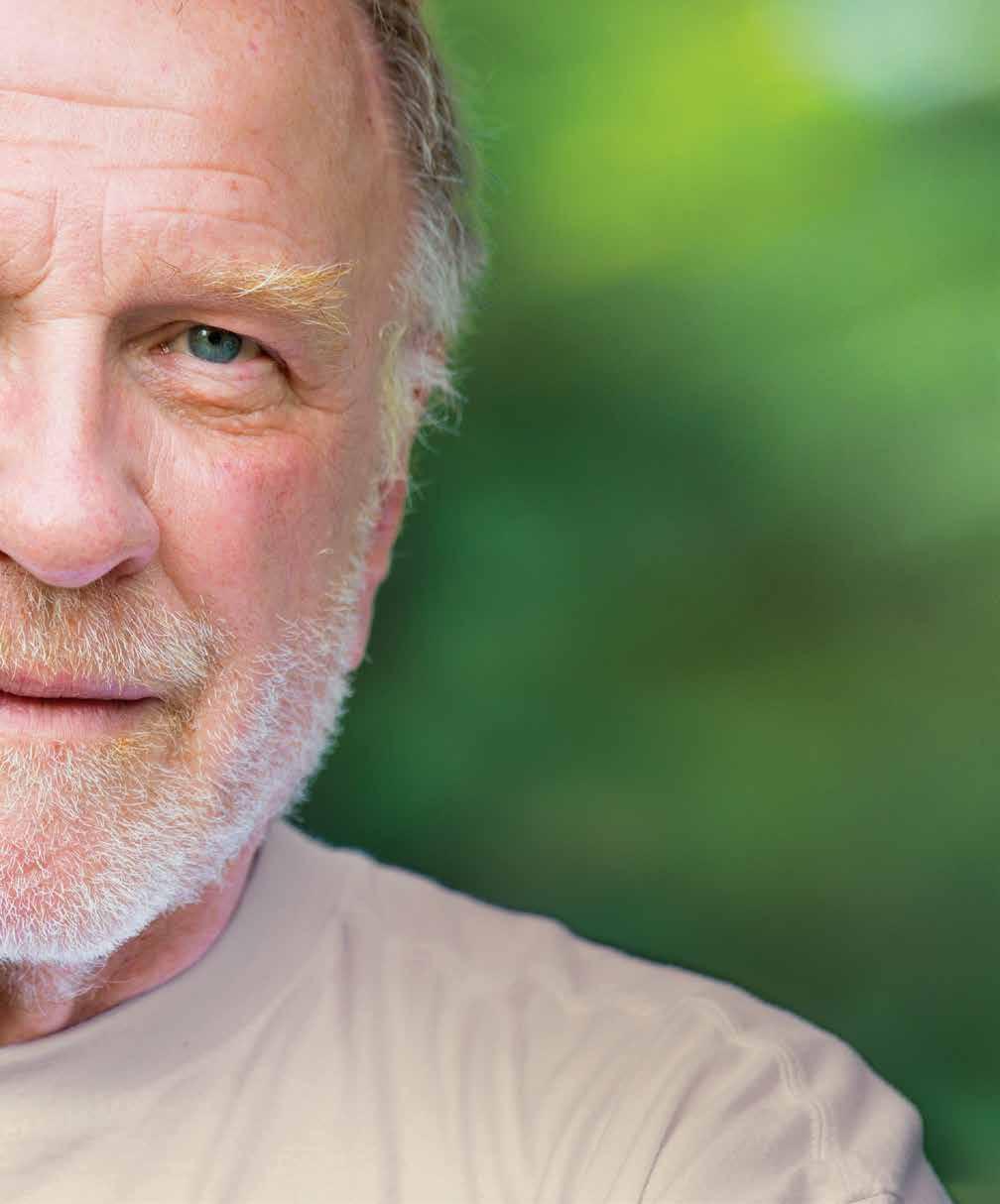
symptoms are good at hiding.
“ Is a little chest pain normal? ”